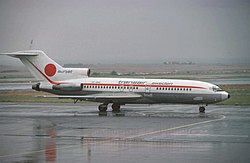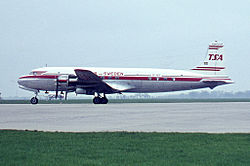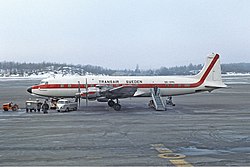Transair Sweden
| Transair Sweden | |
|---|---|

|
|
| IATA code : | (without) |
| ICAO code : | TB |
| Call sign : | (unknown) |
| Founding: | 1950 |
| Operation stopped: | 1981 |
| Seat: |
Malmo Sweden |
| Home airport : |
Stockholm / Bromma (1950–1960) Malmö-Bulltofta (1960–1972) Malmö-Sturup (1972–1981) |
| Fleet size: | 4th |
| Aims: | Mediterranean area , Canary Islands |
| Transair Sweden ceased operations in 1981. The information in italics refer to the last status before the end of operation. | |
Transair Sweden was a Swedish charter airline and from 1975 a subsidiary of Scandinavian Airlines System ( SAS ). The company ceased operations in September 1981.
history

In 1950, founded by Lovén in Stockholm , the airline Nordisk AeroTransport to newspapers on behalf of the local publishers to fly in other Swedish cities. Operations began in the spring of 1951 from Stockholm / Bromma Airport with two Airspeed Consul aircraft , followed by an eight-seat Avro Anson . The Nordisk Aero Transport was established in July 1951 to T ransair S Vedas A B ( TSA renamed). Another Airspeed Consul added to the fleet in May 1952.
In March 1953 Transair Sweden acquired its first Douglas DC-3 in order to offer tourist charter flights (IT charter) to southern Europe. This business idea opened up a completely new market for the company in Scandinavia, because holidaymakers used to travel by bus or train. The first passenger flight took place on April 6, 1953 from Stockholm to Hamburg . A second DC-3 entered service in December 1953. In the winter months with little demand, the company used the machines for occasional services (ad hoc charter) and on behalf of Scandinavian Airlines System ( SAS ) in scheduled services from Stockholm to Gothenburg and Visby . In 1955, Transair Sweden carried 27,375 passengers and 1,622 tons of freight with three aircraft each of the Douglas DC-3 and Airspeed Consul types. Starting in April 1957, the company put a total of eleven former Curtiss C-46 military transporters into service, thereby significantly increasing its charter capacities. However, like the Douglas DC-3, these machines were only conditionally suitable for long distances due to their relatively low speed and limited range. A flight to Palma de Mallorca took up to 12 hours because of the necessary stopovers and refueling. Freight charter flights were also carried out intercontinentally, e.g. B. to Bangkok or Calcutta , where three Bell 47 helicopters were transported on one flight .

In order to reach more distant destinations such as the Canary Islands and to shorten flight times, the company acquired three Douglas DC-6 machines from SAS in early 1960 . In 1960 the company carried 70,000 passengers, including 23,000 passengers to Palma de Mallorca, making Transair Sweden the top European charter airline. In the same year, the company moved its headquarters from Stockholm / Bromma Airport to Malmö -Bulltofta Airport and for the first time carried out a circumnavigation of the world with a tour group. The company also offered IT charter services from Copenhagen-Kastrup Airport from the summer of 1961, and from August 1961 put seven more Douglas DC-6s into service. In 1963 Transair Sweden was taken over by SAS , but in June 1964 it was sold on to the Swedish group of companies Nyman & Schultz . At that time the self-used fleet consisted of eight Douglas DC-6s, one DC-3 and five Curtiss C-46s, further aircraft were leased to the UNO until autumn 1963 and then to Transair Congo . While the DC-6 operated on the IT charter routes, the DC-3 was now operated in the shuttle service between Malmö and Copenhagen . The Curtiss C-46 was mainly used on behalf of SAS on their freight routes from Copenhagen to Amsterdam , Hamburg, Frankfurt , Paris and Stuttgart as well as on domestic Swedish mail flights. In the course of 1965, all but one Douglas DC-6 , which was used as a replacement, was replaced by a larger Douglas DC-7 , which enabled Transair Sweden to increase its transport capacities by around 30%.
In 1966, a new competitor appeared in Sweden with the state-owned Scanair , which was able to rent aircraft from its parent company SAS at special conditions and thus operate more cheaply on the market. In the autumn of 1966, the tour operator Vingresor , which was one of Transair Sweden's main customers , signed charter contracts with Scanair . The company lost around 38,000 passengers in the following holiday season. To increase its competitiveness, Transair Sweden put two leased brand new Boeing 727-100s into service in December 1967 . A third machine from the Boeing 727-100C series (combined passenger / cargo version) was delivered in September 1968. On October 1, 1968, the company entered into a cooperation with Scanair and then used the three Boeings for them as part of a long-term wet lease . Own IT charter traffic was carried out to a reduced extent until 1969 with the Douglas DC-7. The last flight with a propeller plane took place on October 31, 1969 from Munich via Stockholm to Malmö. In the following years, only charter traffic was flown for Scanair , with the company covering their less frequented routes as well as smaller Swedish airports. Due to the insufficient range of the Boeing 727-100, flights to the Canary Islands or Gambia had to be made with a stopover in Billund , Lisbon or Nantes , where the aircraft were refueled.
In 1972 the company moved its headquarters to the newly opened Malmö-Sturup Airport . In 1975, halfway through the 14-year leasing contract, Scanair took advantage of a termination clause to prematurely end its cooperation with Transair Sweden . Due to the efforts of Swedish politicians, the company was not dissolved, but taken over by the state airline SAS . The company then continued its operations for Scanair and acquired a fourth Boeing 727-100QC (quick change version) from Lufthansa in February 1979 . Transair Sweden operated its last IT charter flight on September 6, 1981 from Rhodes to Stockholm. This was followed by the liquidation of the company, whose employees were taken over by the SAS .
UN missions and Transair Congo
The UN hired from December 30, 1960, first two aircraft Curtiss C-46 from the Transair Sweden to this as part of the UN deployment in the Republic of Congo to use the previously briefly independence from Belgium had acquired. The aircraft as well as the pilots and the technical staff were stationed in Leopoldville . In 1961 the company operated six C-46s and one Douglas DC-6 in Africa. Another DC-6 was acquired in the USA in August 1961 and transported from there directly to the Congo. The plane crashed on September 18, 1961. The charter contracts with the UN expired in autumn 1963.
The flight services were then continued on behalf of the Congolese government. Under the name Transair Congo , the company operated four C-46s and one DC-6 in Africa in 1964. The last plane left the Congo in March 1966.
fleet

- Airspeed Consul (operated from 1951 to 1959)
- Boeing 727-100 (operated from 1967 to 1981)
- Curtiss C-46 (operated from 1957 to 1965, used in the Congo until 1966)
- Douglas DC-3 (operated from 1953 to 1964)
- Douglas DC-6 and DC-6B (operated from 1960 to 1967)
- Douglas DC-7B (operated from 1964 to 1969)
Incidents
- On September 18, 1961, a Douglas DC-6B ( registration number : SE-BDY) had an unexplained accident near Ndola in Northern Rhodesia (now Zambia ). UN Secretary General Dag Hammarskjöld and 15 other people were on board the aircraft . It is suspected that the machine was shot down (see also the main article on the charter flight of the UN Secretary General Dag Hammarskjöld ).
- On June 8, 1962, a Curtiss C-46 (SE-CFB) had to be written off as a total loss after a landing accident in Albertville (Congo). People were not harmed. The salvaged front fuselage section was used to repair a sister aircraft.
- On January 13, 1964, a Curtiss C-46 (SE-CFF) of the Transair Congo was irreparably damaged in a takeoff accident in Thysville .
- On March 6, 1966, a Curtiss C-46 (SE-CFG) of the Transair Congo hit a bump in Bunia immediately before touching down . The machine continued the flight to Stanleyville , but was withdrawn there due to the amount of damage.
- On January 20, 1968, the nose landing gear of a Douglas DC-7B operated by Transair Sweden (SE-ERC) collapsed during landing at Munich-Riem Airport . The machine leased to Türk Hava Yollari (THY, now Turkish Airlines) fell off the runway. All 38 occupants (6 crew members and 32 passengers) were uninjured. The aircraft was damaged beyond repair.
See also
Web links
Individual evidence
- ↑ a b c d e f Leisure Airlines of Europe, K. Vomhof, 2001
- ↑ Paul Howard: Sweden's Super Cats, in: Propliner 141 (Winter 2014) (English) , p. 26
- ^ Transair, SE-BUC
- ↑ SFF Kronologi över Flyget I Severige, 1950 - 1959 ( Memento of the original from November 19, 2015 in the Internet Archive ) Info: The archive link was inserted automatically and has not yet been checked. Please check the original and archive link according to the instructions and then remove this notice.
- ↑ Flight International, May 21, 1954 (PDF)
- ↑ Flight International, April 20, 1956 (PDF)
- ↑ Scanair Magazine, Så hittade skandinaverna vägen till solen
- ^ Paul Howard: Sweden's Super C Cats, in: Propliner 141 (Winter 2014) (English) , p. 27
- ↑ Flight International, November 9, 1961 (PDF)
- ↑ a b The TSA History
- ↑ Flight International, May 18, 1972 (PDF)
- ↑ Transair Sweden, SE-ERL
- ^ Transair Sweden, SE-DDD
- ↑ Scanair Magazine, year 1981
- ^ TSA Congo Operations
- ↑ Flight International, April 2, 1964 (PDF)
- ^ Accident report DC-6B SE-BDY , Aviation Safety Network (English), accessed on August 19, 2018.
- ^ Transair Sweden, SE-CFB
- ↑ Curtiss C-46 Commando i Sverige . Svensk Flyghistorisk Tidskrift, ISSN 1100-9837, October 2017 (Swedish), p. 23.
- ^ Accident report Curtiss C-46 SE-CFB , Aviation Safety Network (English), accessed on August 19, 2018.
- ↑ Curtiss C-46 Commando i Sverige . Svensk Flyghistorisk Tidskrift, ISSN 1100-9837, October 2017 (Swedish), p. 24.
- ^ Accident report Curtiss C-46 SE-CFF , Aviation Safety Network (English), accessed on August 19, 2018.
- ↑ Curtiss C-46 Commando i Sverige . Svensk Flyghistorisk Tidskrift, ISSN 1100-9837, October 2017 (Swedish), p. 23.
- ^ Accident report Curtiss C-46 SE-CFG , Aviation Safety Network (English), accessed on August 19, 2018.
- ^ Accident report DC-7B SE-ERC , Aviation Safety Network (English), accessed on March 14, 2019.